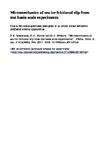Micromechanics of sea ice frictional slip from test basin scale experiments
| dc.contributor.author | Sammonds, PR | en |
| dc.contributor.author | Hatton, DC | en |
| dc.contributor.author | Feltham, DL | en |
| dc.date.accessioned | 2017-01-05T13:51:07Z | |
| dc.date.issued | 2017-02-13 | en |
| dc.identifier.issn | 1364-503X | en |
| dc.identifier.other | 20150354 | en |
| dc.identifier.uri | http://hdl.handle.net/10026.1/8201 | |
| dc.description.abstract |
We have conducted a series of high-resolution friction experiments on large floating saline ice floes in an environmental test basin. In these experiments, a central ice floe was pushed between two other floes, sliding along two interfacial faults. The frictional motion was predominantly stick–slip. Shear stresses, normal stresses, local strains and slip displacement were measured along the sliding faults, and acoustic emissions were monitored. High-resolution measurements during a single stick–slip cycle at several positions along the fault allowed us to identify two phases of frictional slip: a nucleation phase, where a nucleation zone begins to slip before the rest of the fault, and a propagation phase when the entire fault is slipping. This is slip-weakening behaviour. We have therefore characterized what we consider to be a key deformation mechanism in Arctic Ocean dynamics. In order to understand the micromechanics of sea ice friction, we have employed a theoretical constitutive relation (i.e. an equation for shear stress in terms of temperature, normal load, acceleration, velocity and slip displacement) derived from the physics of asperity–asperity contact and sliding (Hatton et al. 2009 Phil. Mag. 89, 2771–2799 (doi:10.1080/14786430903113769)). We find that our experimental data conform reasonably with this frictional law once slip weakening is introduced. We find that the constitutive relation follows Archard's law rather than Amontons' law, with τ∝σⁿ (where τ is the shear stress and σ is the normal stress) and n = 26/27, with a fractal asperity distribution, where the frictional shear stress, τ = f_{fractal}T_{ml}w_s, where f_{fractal} is the fractal asperity height distribution, T_{ml} is the shear strength for frictional melting and lubrication and w_s is the slip weakening. We can therefore deduce that the interfacial faults failed in shear for these experimental conditions through processes of brittle failure of asperities in shear, and, at higher velocities, through frictional heating, localized surface melting and hydrodynamic lubrication. | en |
| dc.format.extent | 0 - 0 | en |
| dc.language.iso | en | en |
| dc.publisher | Royal Society of London | en |
| dc.subject | sea ice friction | en |
| dc.subject | micromechanics | en |
| dc.subject | scaling | en |
| dc.title | Micromechanics of sea ice frictional slip from test basin scale experiments | en |
| dc.type | Journal Article | |
| plymouth.issue | 2086 | en |
| plymouth.volume | 375 | en |
| plymouth.publisher-url | http://rsta.royalsocietypublishing.org/content/375/2086/20150354 | en |
| plymouth.publication-status | Published online | en |
| plymouth.journal | Philosophical Transactions of the Royal Society A: Mathematical, Physical and Engineering Sciences | en |
| dc.identifier.doi | 10.1098/rsta.2015.0354 | en |
| plymouth.organisational-group | /Plymouth | |
| plymouth.organisational-group | /Plymouth/Faculty of Science and Engineering | |
| plymouth.organisational-group | /Plymouth/REF 2021 Researchers by UoA | |
| plymouth.organisational-group | /Plymouth/REF 2021 Researchers by UoA/UoA12 Engineering | |
| dcterms.dateAccepted | 2016-11-07 | en |
| dc.rights.embargodate | 2017-12-26 | en |
| dc.rights.embargoperiod | 12 months | en |
| rioxxterms.versionofrecord | 10.1098/rsta.2015.0354 | en |
| rioxxterms.licenseref.uri | http://www.rioxx.net/licenses/under-embargo-all-rights-reserved | en |
| rioxxterms.licenseref.startdate | 2017-02-13 | en |
| rioxxterms.type | Journal Article/Review | en |


